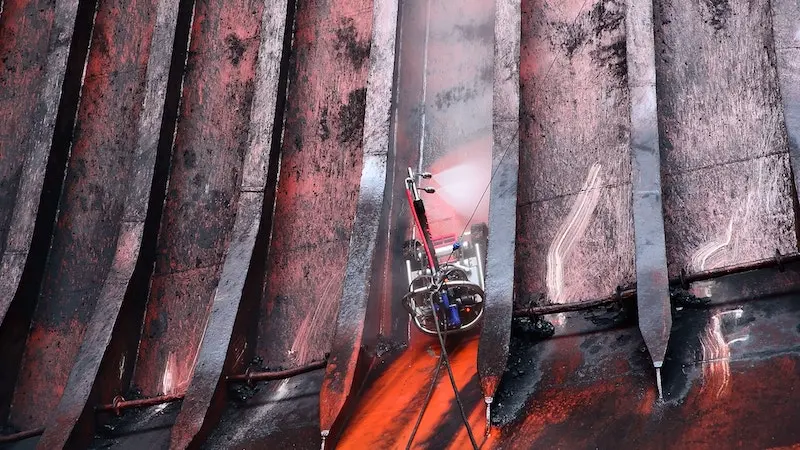✉️ [email protected] | 📞 +971-4-2675252
Home / Applications / Cargo hold cleaning
Cargo hold cleaning
Cargo Holds of dry/liquid bulk carriers require a certain degree of cleaning when changing cargo. Such cleaning is time-consuming and at times, a hazardous task for the crew, which can be performed mainly while in port.
Cargo hold cleaning
Why are cargo holds cleaned?
The regular maintenance and cleaning of bulk carriers are considered to be an essential part of retaining a consistently smooth operation. As mentioned, this is especially important within the heavily used cargo hold area which securely houses products throughout the duration of voyages. Ship cargo hold cleaning, according to regulatory requirements, must be conducted every time a shipment is unloaded and before the next load of product is placed into the hold. There are various explanations as to why this is deemed important such as:
1. To View Hidden Vessel Damage: Cleaning the cargo hold regularly ensures that any visible damage recently caused can be viewed and subsequently tested. Failing to clean the hold can potentially hide existing damage and present a risk to the product being transported, the health and safety of the crew and even, to the bulk carrier itself.
2. To Prevent Cargo Contamination: This can be seen through insufficient or lack of regular hold washing. When contamination is found by a port/vessel’s inspector, they are likely to restrict the movement (and thus the productivity) of the subject vessel and crew until an efficient cargo hold clean has been carried out. Furthermore, if by chance an inspection of the cargo hold is approved when contamination is present, the next shipment of product will likely develop contamination by being in contact with the unsanitary space.
– For example: If the remnants of sugar from a previous shipment is not cleaned away properly, that sugar will ferment. Now when we place a new batch of sugar to be transported into that hold it will also very likely become fermented. From here the best case scenario is that a percentage of the sugar would have to be discarded (wasting much time, money and sugar) and in the worst case it could potentially be consumed (causing a spread of serious illness, hospitalization).
3. To Avoid Additional Costs: It may be obvious by now that many additional costs subsequently arise when cargo cleaning is overlooked. Product can be lost, the vessel itself can become damaged, excessive quantities of time can be spent and additional safety risks can increase. All scenarios will dramatically add to the costs of shipping goods. Cleaning the cargo hold is a simple step towards preventing these scenarios and any of the costs associated.
Cargo hold cleaning
What are the methods used to clean cargo holds?
The cargo hold is most often cleaned through manual labor. The cleaning system varies with its order from vessel to vessel but in general: a sweep of the hold area is completed, the walls of the hold are rinsed with fresh water/cold sea water and finally, a special cleaning additive is applied to all surfaces to remove any tough residue. The process of manual labor involves the expense of a lot of manpower, time and fails to guarantee complete efficiency.
However, the most noteworthy problem with manual cleaning are the health and safety hazards that are associated with it. As cleaning workers are required to physically enter the cargo hold to conduct the clean-up, the overall likelihood for human error sourced accidents increases significantly. Maritime surveyors demonstrated this through the statistics taken from a total of 4104 ship oriented accidents analyzed, 65.8% were caused by human actions. Alongside this, from all accidents that currently occur on bulk carriers, a massive 50% are happening within or around the cargo hold area. The most common hold-cleaning accidents are slipping, falling and loss of control of machinery. In short, manual cargo hold cleaning is a dangerous task which puts crew members at significant risk.
Fortunately for ship owners and H&S staff, the VertiDrive team has counteracted hazardous manual labor efforts by producing remote controlled cargo hold cleaning equipment such as the Magnetic Robot Crawler, the VertiDrive M8.
Vertidrive
Vertidrive cargo hold cleaning solutions
The VertiDrive M8 is an innovative remotely operated cargo hold robot that assists with cargo hold cleaning that is safer, faster and more cost-efficient. High pressure water jets reduce cleaning efforts down to just a single pass with the overall cleaning chemical and water usage minimalist substantially. Powerful magnets allow the M8 to securely operate across surfaces including locations based at an overhead, in corners, and on curvetures with zero loss of grip. The M8 needs an operator to set up, manage and supervise the cleaning. This operator can be based at a safe distance and is the only person required for the cleaning thus, heavily minimizing labor associated costs and health and safety risks.
Benefits
Benefits of Using Vertidrive for cargo hold cleaning
- Multi-purpose
- No need for scaffolding or cherry pickers
- Turns the work into a one-man job
- Safe, clean and efficient operations
- Closed systems available
- Low maintenance robots
- User friendly




Vertidrive M8
- 45m2 / 485 ft2 per hour
- 5x faster than manual work
- Horizontal and vertical surfaces
- Closed hydroblasting and vertical surfaces
- 400mm(15.5″) cleaning width
- Remote Controlled
- Easy to (dis)assemble
- Convertible to Vertidrive M3
- Versions: Electric, Pneumatic, ATEX Zone II
- Fits through 24″ manhole
